
© Erik Tomasson. (Click image for larger version)
San Francisco Ballet,
Caprice, Hummingbird, Symphonic Dances
Paris, Théâtre du Châtelet
16 July 2014
www.sfballet.org
chatelet-theatre.com
San Francisco Ballet’s two-week-plus season in Paris celebrates the tenth anniversary of the city’s summer dance festival. SFB inaugurated the first, set up to fill the lamentable lack of first-rate performances during the summer. Parisians assume that when they go away on holiday, the city might as well close down.
The initial idea was to invite dance companies to perform in the open air outside palatial buildings. It rained, of course. I remember how gallantly the San Francisco dancers, cold and wet, accomplished their al fresco programme in 2005, spectators huddled under umbrellas. Now under cover, the festival has taken place for the past six years in the Châtelet Theatre, run by Jean-Luc Choplin (briefly director of Sadler’s Wells).
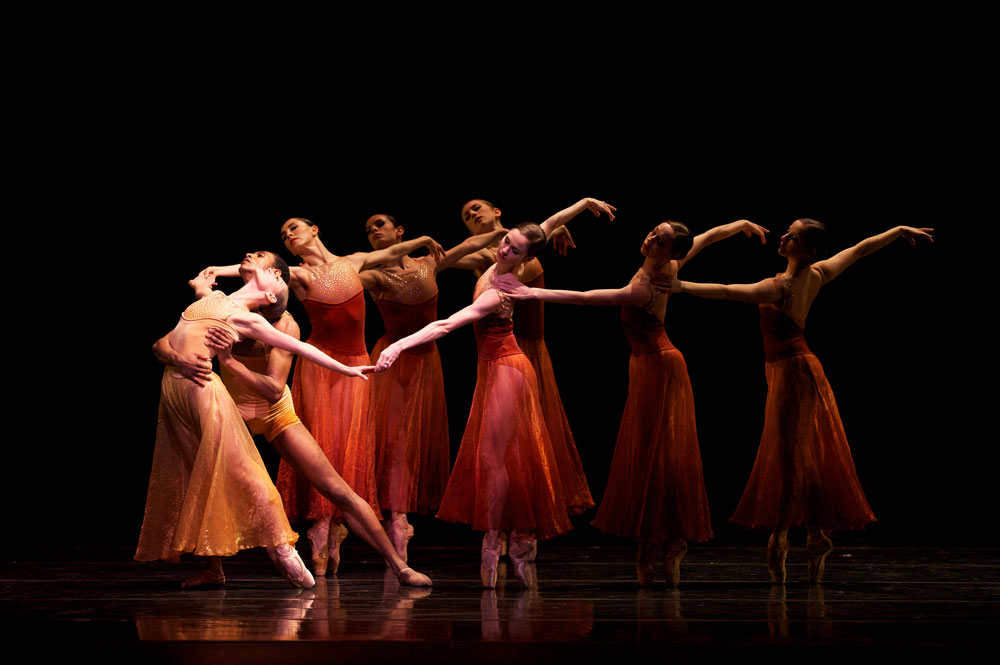
© Erik Tomasson. (Click image for larger version)
It’s always a pleasure to see SFB, not least because Helgi Tomasson, their artistic director, commissions so many new works from interesting choreographers. During the Châtelet season, the company presents 18 ballets, nine of them new to Paris, in a different triple bill each night. Fortunately, the dancers are accustomed to a similarly busy schedule at home in the San Francisco Memorial Opera House. In Paris, young musicians of L’Orchestre Promethée cope gamely with a wide range of composers at every performance, conducted by SFB’s Martin West or Ming Luke.
The first triple bill I saw had a very recent ballet by Liam Scarlett, Hummingbird (April 2014) to music by Philip Glass. His Tirol Concerto for Piano and Orchestra contains references to traditional Tyrolean tunes: the mountainous context might have influenced John Macfarlane’s décor, a vast curved drop cloth with grey and black streaks resembling a glacier. It partially lifts to reveal a ramp over which dancers in grey emerge like the participants in Kenneth MacMillan’s Gloria.
Hummingbird opens with a solitary woman, Frances Chung, dancing reflectively to a piano melody. She is soon joined by Gennadi Nedvigin in a turbulent partnership, in which she asserts herself with rebuffs. A corps of 12 in outfits resembling old-fasioned everyday clothes swirls around them until the surging music suddenly calms. The corps depart and the central couple look abashed to witness the grief of a new arrival, a woman in white, Yuan Yuan Tan.
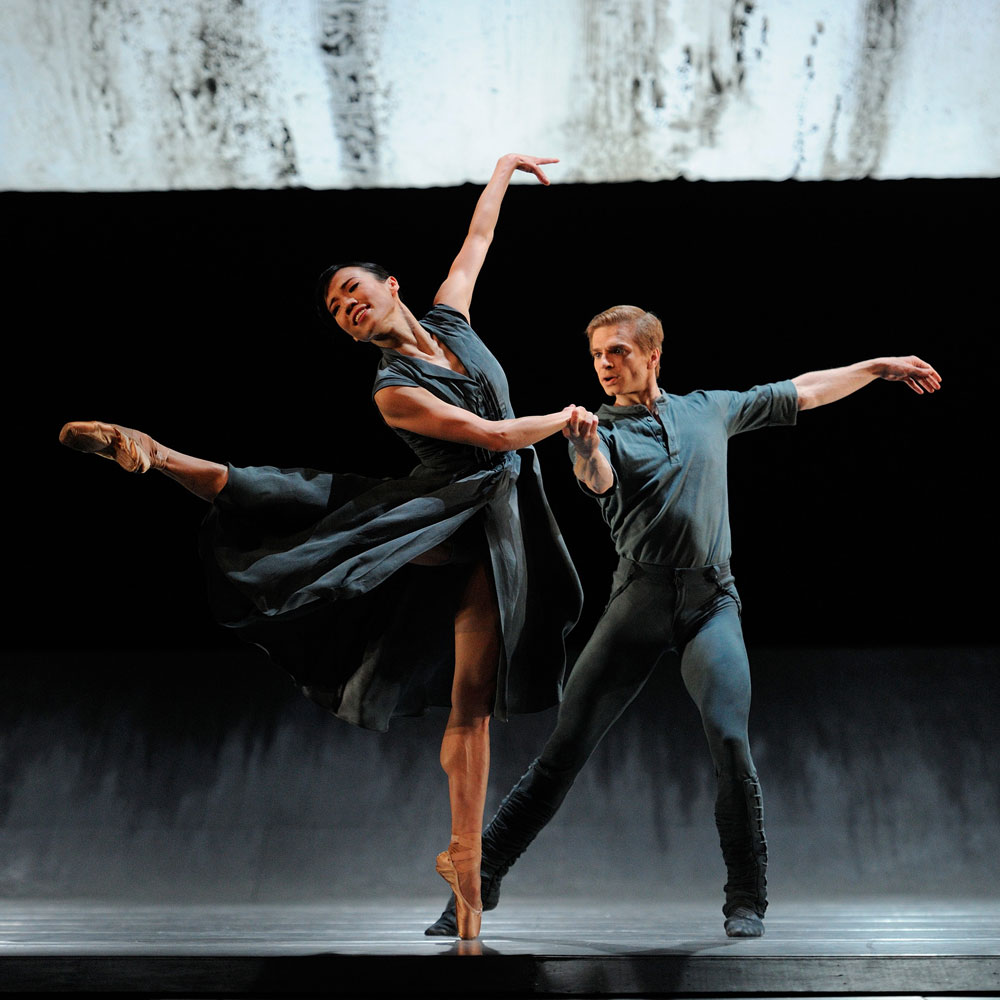
© Erik Tomasson. (Click image for larger version)
Left alone, she entwines her slender arms in agonised shapes, arches her body forwards in an access of longing. When a man in white, Luke Ingham, appears, she almost swoons in his arms, craving his embrace. I’d say he’s a ghost and the long middle movement of the concerto is her re-living of their relationship and the phases of her grief as she mourns.
There is no programme note or explanation of Scarlett’s choice of title. Yet a narrative element is evident in the ballet, with strong emotional impulses for the movement, as well as a response to the music. The concerto’s middle movement is full of yearning, melancholic, nostalgic, occasionally spirited. Yuan Yuan Tan gives herself over to body-wrenching spasms of despair, sometimes rejecting Nedvigin’s consoling arms, then letting him swing her joyously, as he would have done in the past. At one point, they pace slowly across the front of the stage, gazing into each other’s eyes, as other couples pass by in silhouette.
David Finn’s lighting shifts the emphasis from foreground to background, isolating the ghostly pair or losing them among the crowd going about their heedless business. The opening movement couple reappear; others, including two men, dance together jubilantly, watched ruefully from the ramp by Ingham, set apart. When the men leave, the women dispose themselves on the ramp like the weary soldiers in Gloria. There’s a lot going on during the 16 minutes of the central movement of the concerto – so much so that the two leading men, Ingham and Nedvigin, gasp loudly in exhaustion, hands on knees, heads bowed.
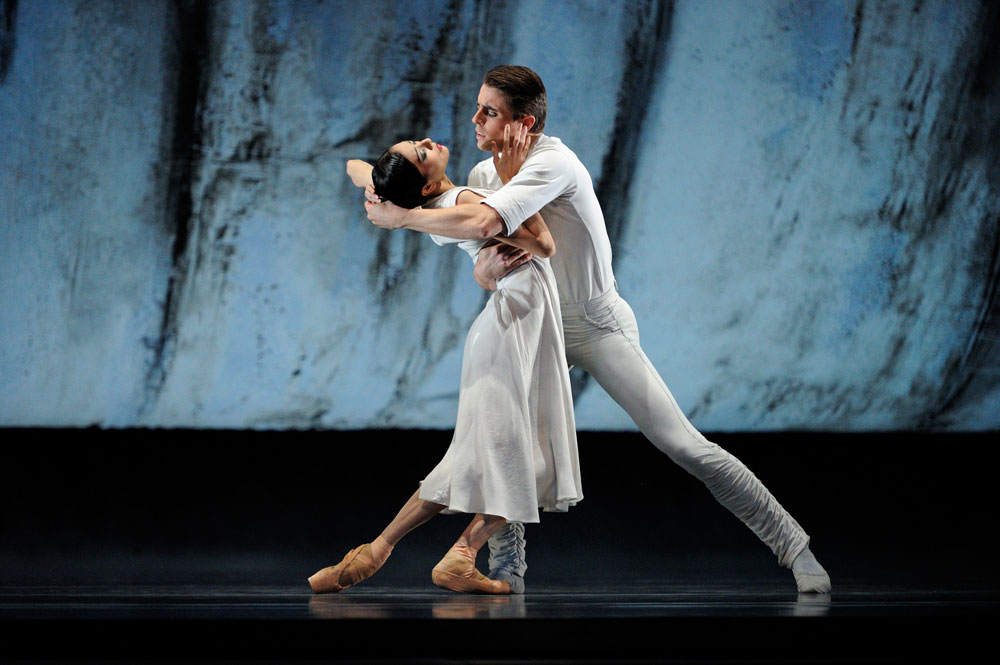
© Erik Tomasson. (Click image for larger version)
The difficulty is that any narrative thread becomes entangled among all the motives for movement, so that when the Tan/Ingham pas de deux eventually resumes, their running apart and rushing together seems redundant as a farewell. A downbeat ending is clumsy, as she walks off and he follows instead of vanishing. There can be no conclusion since the final movement is yet to come.
Maria Kochetkova bounces on brightly, partnered by Jaime Garcia Castilla in a pas de deux of twists and turns to piano arpeggios. Chung and Nedvigin return, still feisty but exuberant. Music and steps from the first movement are reprised and and the backdrop descends, lit from behind. The ballet’s structure is baffling at a first viewing, unless it is to be seen simply as a set of unconnected emotional reactions to the oddly-paced Tirol Concerto. If the three couples represent phases of the same relationship, as in Jerome Robbins’s In the Night or Antony Tudor’s The Leaves Are Fading, the carefree episode occurs too late.
Among Scarlett’s considerable virtues as a dance maker is his skill at using a large corps effectively, without depending on pas de deux to carry the intensity of his choreography. He always appears to have urgent ideas to communicate, though his meaning can be unclear. The two works on either side of Hummingbird, Tomasson’s Caprice and Edwaard Liang’s Symphonic Dances, made up a far-too-similar programme of pas de deux complemented by a dozen or so corps, semi-abstract without any discernable emotional logic.
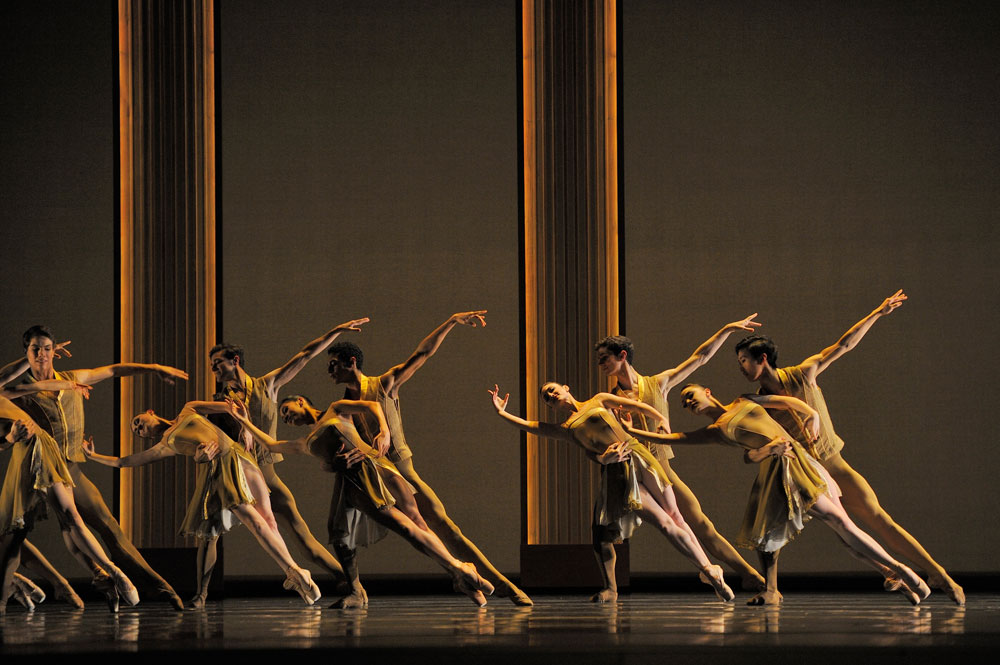
© Erik Tomasson. (Click image for larger version)
Caprice (April 2014) is set to Camille Saint-Saens’s Symphony no 2, with an additional adagio from no 3. Two main couples are contrasted: Mathilde Froustey and Vitor Luiz, elegant and lyrical, Tiit Helimets and Sarah Van Patten, dramatic and expansive. Towards the end, they echo each other in a double duet, their different qualities apparent. Tomasson’s choreography is very musical, with Saint-Saens sounding as obligingly dansant as Tchaikovsky. Six young couples enjoy themselves, showing off in groups or breaking into virtuoso trios. A grand finale has them all leaping aloft in a version of a Balanchine applause machine. Caprice is an engaging opener, set against mobile classical pillars, bathed in a golden glow.
Liang’s Symphonic Dances (2012), to Rachmaninov’s music of the same name, is stormy, unnecessarily tortuous. Women in flaming orange skirts whirl to an infernal Dies Irae, while gorgeous Sarah Patten glares at Anthony Spaulding, who is required to haul her around and turn her upside down, culminating in a fireman’s lift over his shoulder. He can’t disguise the awkwardness of the lifts in partnering that verges on the abusive.

© Erik Tomasson. (Click image for larger version)
Sliding, floor-based manouevres for the first and third pas de deux look more appropriate for ice-skating competitions. Frances Chung and Lorena Feijoo, clinging to their partners, keep being senselessly dumped on the ground then yanked upright. The corps of twelve form lines that break into canons, as bombastic as the music. Rarely have I seen quite such unbecoming costumes, cut off at just the wrong places for both sexes.
Audience applause during the evening recognised that Scarlett’s Hummingbird was the starry centrepiece of the three Paris premieres. It is to be performed again towards the end of the second week, 24 and 26 July.














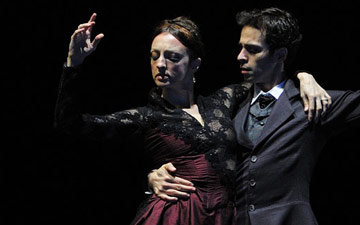
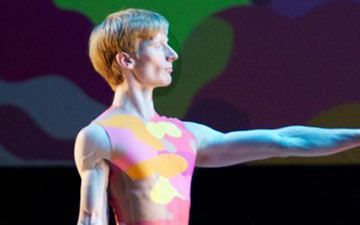
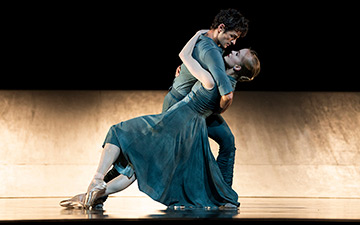
You must be logged in to post a comment.